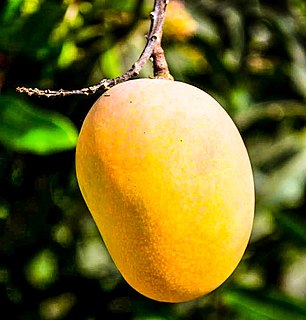
A mango is an edible stone fruit produced by the tropical tree Mangifera indica. It is believed to have originated in the region between northwestern Myanmar, Bangladesh, and northeastern India. M. indica has been cultivated in South and Southeast Asia since ancient times resulting in two types of modern mango cultivars: the "Indian type" and the "Southeast Asian type". Other species in the genus Mangifera also produce edible fruits that are also called "mangoes", the majority of which are found in the Malesian ecoregion.

The Tortricidae are a family of moths, commonly known as tortrix moths or leafroller moths, in the order Lepidoptera. This large family has over 11,000 species described, and is the sole member of the superfamily Tortricoidea, although the genus Heliocosma is sometimes placed within this superfamily. Many of these are economically important pests. Olethreutidae is a junior synonym. The typical resting posture is with the wings folded back, producing a rather rounded profile.

The apple maggot, also known as the railroad worm, is a species of fruit fly, and a pest of several types of fruits, especially apples. This species evolved about 150 years ago through a sympatric shift from the native host hawthorn to the domesticated apple species Malus domestica in the northeastern United States. This fly is believed to have been accidentally spread to the western United States from the endemic eastern United States region through contaminated apples at multiple points throughout the 20th century. The apple maggot uses Batesian mimicry as a method of defense, with coloration resembling that of the forelegs and pedipalps of a jumping spider.

The Tephritidae are one of two fly families referred to as fruit flies, the other family being the Drosophilidae. The family Tephritidae does not include the biological model organisms of the genus Drosophila, which is often called the "common fruit fly". Nearly 5,000 described species of tephritid fruit fly are categorized in almost 500 genera of the Tephritidae. Description, recategorization, and genetic analyses are constantly changing the taxonomy of this family. To distinguish them from the Drosophilidae, the Tephritidae are sometimes called peacock flies, in reference to their elaborate and colorful markings. The name comes from the Greek τεφρος, tephros, meaning "ash grey". They are found in all the biogeographic realms.

The Gambian epauletted fruit bat is a species of megabat in the family Pteropodidae.
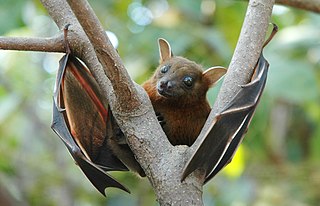
The lesser short-nosed fruit bat is a species of megabat within the family Pteropodidae. It is a small bat that lives in South Asia and Southeast Asia. It weighs between 21 and 32 grams, and/or 70 to 127 mm. It occurs in many types of habitat, but most frequently in disturbed forest, including lower montane forest and tropical lowland rain forest, plus gardens, mangroves, and vegetation on beaches.
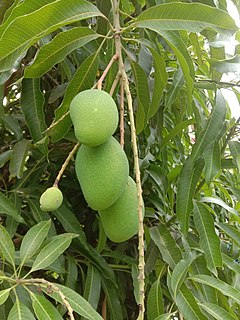
Mangifera indica, commonly known as mango, is a species of flowering plant in the family Anacardiaceae. It is a large fruit tree, capable of growing to a height of 30 metres. There are two distinct genetic populations in modern mangoes – the "Indian type" and the "Southeast Asian type".
Merrifieldia tridactyla, also known as the western thyme plume, is a moth of the family Pterophoridae, first described by Carl Linnaeus in his 10th edition of Systema Naturae in 1758. It is known from most of Europe, as well as North Africa and Asia Minor.
The 'Young' mango, also known as the 'Tebow', is a mango cultivar that originated in south Florida.
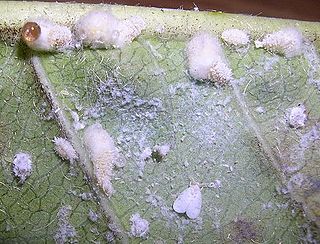
Paracoccus marginatus, commonly known as the papaya mealybug, is a small sap-sucking insect in the mealybug family, Pseudococcidae. It is found on a number of different hosts, including economically important tropical fruit trees and various ornamental plants.

Pleuroprucha asthenaria, the asthene wave moth, is a moth of the family Geometridae. It is known from North America, South America and Jamaica.

Deanolis sublimbalis, the red banded mango caterpillar, is a moth of the family Crambidae. The species was first described by Pieter Cornelius Tobias Snellen in 1899. It is found in India and Indonesia (Sulawesi), Papua New Guinea, Myanmar, Thailand, China, Brunei and the Philippines. In 1990 it was first recorded in Australia in the Torres Strait and in 2001 it was detected on the Australian mainland in the Northern Peninsula Area at the tip of the Cape York Peninsula in Queensland.
Citripestis sagittiferella, the citrus fruit borer, is a species of snout moth in the genus Citripestis. It was described by Frederic Moore in 1891. It is found in Indonesia, Malaysia, Singapore and Thailand.
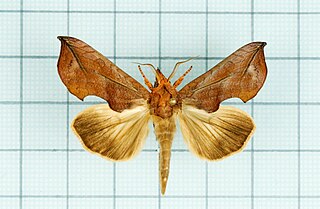
Oraesia excavata is a species of moth of the family Erebidae first described by Arthur Gardiner Butler in 1878. It is found in Japan, Korea, China, Thailand and Taiwan and has recently been recorded from Hawaii.
Euhyponomeutoides albithoracellus, the currant bud moth, is a moth of the family Yponomeutidae. It is found in Fennoscandia, Denmark, Germany, Poland, the Baltic region, Romania, Slovakia, Austria, Switzerland and France.
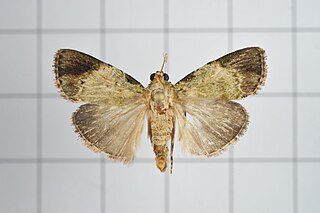
Orthaga euadrusalis, the mango leaf webber, is a species of snout moth in the genus Orthaga. It was described by Francis Walker in 1858. It is found on Borneo and in India.
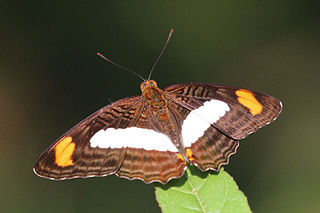
Adelpha iphiclus, the Iphiclus sister, is a butterfly of the family Nymphalidae. It was described by Carl Linnaeus in his 1758 10th edition of Systema Naturae. It is found in the tropics and sub-tropics of Central and South America, from Mexico to Bolivia. The habitat consists of disturbed areas in deciduous and evergreen forests at altitudes ranging from 0 to 1,200 meters.

Bactrocera carambolae, also known as the carambola fruit fly, is a fruit fly species in the family Tephritidae, and is native to Asia. This species was discovered by Drew and Hancock in 1994.
Deporaus marginatus, commonly known as the mango leaf-cutting weevil, is a species of leaf weevil in the beetle family Attelabidae. It is a light tan colour with black elytra, and is found in tropical Asia where it is a pest of mango.
Bactrocera passiflorae, the Fijian fruit fly, is a species of fly in the family Tephritidae in the insect order Diptera. It is native to several tropical and subtropical islands in the Pacific Ocean and is a pest of fruit crops.













